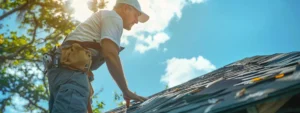Florida’s unique climate presents a host of challenges for homeowners.
Among these, roofing problems are particularly common and can lead to significant damage if not addressed promptly.
This article aims to shed light on the common roofing problems in Florida’s climate. It will delve into the impact of factors such as high humidity, strong UV radiation, and frequent storms on the integrity of your roof.
We will also explore preventative measures that can help mitigate these issues. These include regular maintenance, choosing the right materials, and understanding the signs of damage.
Whether you’re a homeowner, property manager, or real estate investor, this guide will equip you with the knowledge to protect your property effectively.

Understanding Florida’s Unique Climate and Its Impact on Roofs
Florida’s climate is characterized by high humidity, strong UV radiation, and frequent storms, including hurricanes. These conditions can wreak havoc on roofing systems, leading to a range of problems from moisture damage to shingle deterioration.
Moreover, the state’s coastal location exposes roofs to saltwater corrosion, further accelerating wear and tear. Understanding these unique climatic challenges is the first step towards effective roof maintenance and prevention of serious damage.
The Top Roofing Challenges in Florida
Florida’s unique climate presents several challenges to homeowners. These challenges can lead to a variety of roofing problems, each with its own set of complications.
Some of the most common roofing problems in Florida include:
- Moisture and mold damage
- UV radiation effects
- Storm and hurricane damage
- Wind and hail damage
Moisture and Mold: The Silent Destroyers
Moisture damage is a common issue in Florida’s humid climate. It can lead to the growth of mold and mildew, which can weaken the roof structure over time.
Regular inspections and maintenance can help detect and address these issues early, preventing extensive damage and costly repairs.
UV Radiation: The Invisible Culprit
Florida’s strong UV radiation can cause roofing materials to become brittle and crack. This can lead to leaks and other structural issues.
Choosing the right roofing materials and regular application of UV-protective coatings can help mitigate these effects.
Storm and Hurricane Damage: Preparing for the Inevitable
Storms and hurricanes can cause significant damage to roofs. This includes missing shingles, leaks, and compromised roof structures.
Installing hurricane straps and ensuring proper roof-to-wall attachments can help mitigate the impact of these severe weather events.
Wind and Hail: The Abrasive Forces
Wind and hail can cause punctures and remove protective granules from roofing materials. This can lead to leaks and other structural issues.
Regular inspections and maintenance, along with the use of impact-resistant materials, can help protect roofs from these abrasive forces.
Preventative Measures to Protect Your Roof
Preventative measures are key to maintaining the integrity of your roof. They can help identify potential problems early and prevent minor issues from becoming major problems.
Regular inspections, choosing the right materials, and proper maintenance are all crucial elements of a preventative approach. These measures can help ensure the longevity of your roof and protect your home from the harsh Florida climate.
Regular Inspections: Your First Line of Defense
Regular roof inspections are your first line of defense against roofing problems. They can help identify potential issues before they become serious problems.
Professional roof inspections can provide a more thorough assessment of your roof’s condition. They can detect signs of damage that may not be visible to the untrained eye.
Choosing the Right Materials: A Long-Term Investment
Choosing the right roofing materials is a long-term investment in your home. Materials such as metal or tile can resist damage from Florida’s harsh weather conditions.
Energy-efficient roofing options can also help reduce cooling costs in Florida’s hot climate. They can reflect UV rays and help keep your home cooler.
Maintenance Tips: Keeping Your Roof in Top Shape
Proper roof maintenance is crucial in Florida. It can prevent minor issues from becoming major problems and extend the lifespan of your roof.
Here are some maintenance tips to keep your roof in top shape:
- Clean gutters regularly to prevent water overflow and damage.
- Trim overhanging tree branches to prevent them from damaging your roof.
- Check for signs of wear and tear regularly, such as missing shingles or water stains on ceilings or walls.
- Seal roof penetrations and flashings to prevent leaks and water damage.
- Ensure proper attic ventilation to prevent heat and moisture buildup that can damage the roof.
When to Call the Professionals: Signs of Roofing Problems
Knowing when to call a professional for roof repairs is crucial. Some signs of roofing problems are obvious, while others may be more subtle.
Visible signs of damage, such as missing shingles or leaks, require immediate attention. Other signs, like water stains on ceilings or walls, may indicate a hidden problem. If you notice any of these signs, it’s time to call a professional for a thorough roof inspection.
Conclusion: Staying Ahead of Roofing Problems in Florida
In conclusion, Florida’s unique climate presents a range of challenges for roofs. However, with regular maintenance, the right materials, and timely repairs, these problems can be managed effectively.
Remember, staying ahead of roofing problems not only protects your home but also saves you money in the long run. So, be proactive and keep your roof in top shape to withstand Florida’s harsh weather conditions. For more information, visit AJ Wells Roofing or call us at 904-799-6499.



